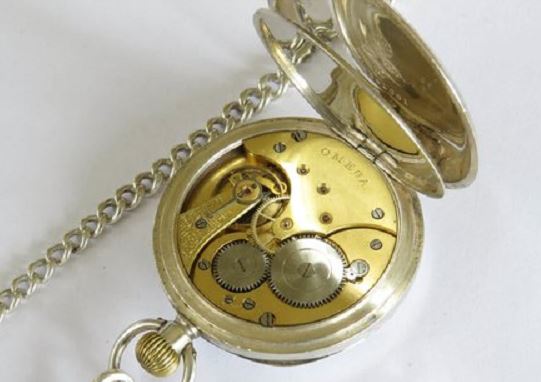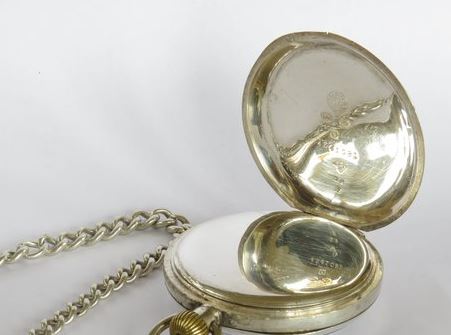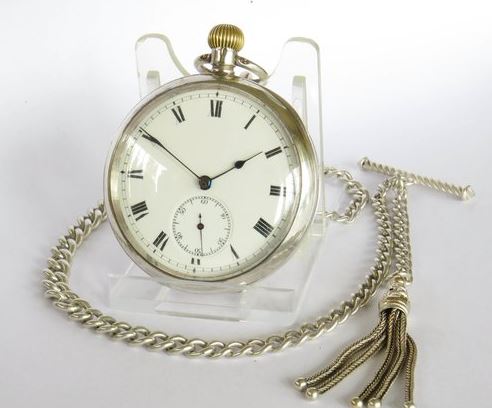Last updated on June 23, 2024
Omega is a very well-respected name in horology. They have a long history, stretching back over 170 years at the time of writing. Most serious watch collectors of both modern and antique timepieces will want an Omega in their collection. Modern collectors will almost certainly want to include an Omega Speedmaster, the iconic moon watch, in their collection. Antique collectors, given the long history of timepieces, have a huge number of watches to select from for their collections. I am no different, I have wanted to add an Omega to my collection for a long time. Finally, I have managed to acquire this antique 1909 silver Omega pocket watch and chain.
Movement
The watch has a 15-jewel stem-winding movement which is working well. The Swiss made movement is signed Omega and it is all protected by an inner hinged cover. Based on the measurement of the movement, 40mm, it is most likely an 18”’ ligne Omega movement. This particular movement was manufactured between 1894 and 1911. Typically, they were an open-face calibre, with a bimetallic screw balance with 4 adjustment screws and a Breguet hairspring. The power reserve, when new, was 34 hours.
Omega history
Louis Brandt (1825-1879) founded Omega in 1848 in La Chaux-de-Fonds, Switzerland. He worked out of a small workshop in the family home. The original company was known as La Generale Watch Co. In the beginning, Brandt assembled key-wound pocket watches made from parts supplied by local craftsmen. He sold his pocket watches throughout Europe. However, England was his most profitable market. Louis Brandt died in 1879. His sons, Louis-Paul and César, took over the family business. They were both inspired by their father’s passion for producing high-quality pocket watches.
In 1894, the company developed a new movement, the 19 ligne calibre. It was produced using revolutionary new methods and set new standards for watchmaking. The 19 ligne was the first movement to allow the combination of winding and setting the time via the crown. Previously, watches were wound and set by a key. It was also an extremely accurate movement that could be worked on by any watchmaker in the world without the need for modifying parts. The brothers named the new movement ‘Omega’, a name that symbolises the end of a significant project. The movement was extremely successful and popular with the public. Its success ensured that the future of watchmaking was to be with series-produced movements. After the ongoing success of the 19 ligne calibre, the company officially adopted the brand name Omega in 1903.
Case
This Omega pocket watch measures 47mm in diameter excluding the winding stem and the loop. The case is slightly smaller than the standard 50mm for a pocket watch. It is still definitely a man’s pocket watch as women’s pocket watches are typically about 35mm in diameter. The case is silver and there are hallmarks inside the two case backs for London (import mark), dating to 1909. This corresponds with the Omega serial number 4341081. There is also an importer’s mark SA and an early Omega logo. Under magnification, there is also a scratched initial and a date of 8.44. This is likely a watchmaker’s mark. It probably indicates the date of a service or repair in August 1944.
Selling Agency (SA), was first registered with the London Assay Office in 1907. It was listed as a gold and silver watch importer. The year 1907 was significant as a law was passed that required all gold and silver watches imported into Britain to be assayed and hallmarked in a British assay office. They were stamped with new hallmarks that showed that the item was imported and not of British manufacture. The Selling Agency company was a subsidiary of Dimier Brothers. It was most likely registered to facilitate the import of Omega watches. The case is in very nice condition for such an early piece. It has one slight bruise to the side and just a hint of unevenness to the case back. These marks are simply patina. They don’t detract from the appearance of the watch at all. If anything, it adds character.
Dial
The watch’s crystal lens is in mint condition. It is likely that this is the original crystal as most replacements tended to be with a more durable acrylic lens. The dial is in mint condition. It has the original blued steel hands, Roman numeral hour markers, a subsidiary seconds dial and an outer minute track. The watch comes with a single chain, 34cm long including the T-bar and the clasp. Each of the links on the chain has the lion silver mark. However, I cannot see a date hallmark. The single Albert chain is quite fine, but it suits the slightly smaller size of the case. The watch and chain came in a new presentation box, which is useful for storage.
My collection
Overall, this is a very presentable pocket watch from one of the finest names in the history of watchmaking. It ticks strongly and has an impressive power reserve of 30 hours. However, on the timekeeping test, it was a marginal performer in comparison to my other watches, running at 3 minutes fast over 24 hours. I managed to trim a few seconds off by using the regulator. However, for a lot of collectors and dealers, 3 minutes, would be considered very acceptable for an antique timepiece. I am sure a service will improve the timekeeping. In general, I am very happy with the addition of this antique Omega pocket watch to my collection.
Related content
Wikipedia – Omega SA.



